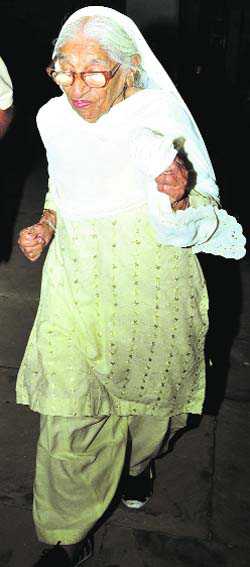Ek tha raja…aur bahot si rani!
She’d remind you of an oft-repeated, varyingly described popular tale, akin to a limerick: ‘ek tha raja, aur ek thi rani/bahot sari rani (there was a king and a queen, maybe, so many queens’). The rest of the two-line tale is: dono mar gaye…khatm kahani (they died, that’s the end of the story). For Man Kaur, 101 (or as old as the wrinkles she wears), the splendour of the princely state of Patiala remains undying, unsurpassable — she was a part of it as an assistant for the queens of colourful Maharaja Bhupinder Singh.
She has a treasure of stories — her own, though, runs quite differently, at times, in parallel. From the present, she is a winner of over 20 medals in 100m, 200m and 400m races in tournaments held across the world. Popular as ‘Bebe Man Kaur’, she is like Fauja Singh, the famous Marathon runner, elder than her by a few years. Her feat in the Patiala Marathon 2016 set her apart. Her Patiala visit, however, was not about the Marathon alone.
She always wished to see the chamber of eldest Maharani Bakhtawar Kaur. “She dreamed of it,” says her son Gurdev Singh, 78, a veteran athlete. A few days back, when she visited Patiala, the Marathon organisers arranged her stay in a Heritage Hotel, Neemrana, in the Baradari Garden. It was a renovated version of the famed Rajindra Kothi.
“I could not believe my luck! I was staying in Room Number One of the hotel, the place where the Maharani lived. Lying on that bed, I relived my whole life in a blink: I was not only seeing the chamber but was also a guest! Maybe, God has kept me alive for the moment,” says Man Kaur. It was a homecoming for someone who tended to four of the 360 concubines of the Maharaja in the 1930s. “My biggest moment,” she exclaimed.
At her Sector 40 residence in Chandigarh, she calls the time gone by as golden. She shuttles between Chandigarh and Canada and as anti drugs activist.
From the recesses of her memory:
“It is said that kings ordered executions at the slightest of pretexts. It is true to some extent. But now governments protect killers (many not hanged despite death sentences) and commoners end life,” she says alluding to farmer suicides. “Those were good times. The king was much loved. The Moti Bagh Palace was full of life. My father was a cook in the royal kitchen. I was married to a cook in his team. Hundreds of workers served in the royal harem. The concubines with their children and aides lived in the Zenana. The senior-most queen was Bakhtawar Kaur, who lived in Rajindra Kothi in the Baradari Gardens.”
The concubines were pampered, she says. “They got up late and had breakfast at 11 am. They were choosy and temperamental. I served my queen with practically everything she asked for — from food to prepare her for bath to listening to her and to accompany her to excursions.
“When the queens moved out, an advance team ensured the route was clean and clear. Anyone who was on the road would be on one’s knees, head bowed, till the cavalcade passed. No one could be on a higher perch than the queen’s palanquin or Baghhi or a car. The king had a large fleet of Rolls Royce cars.
“Every summer, we migrated to the royal palace in Chail. Imagine all the 360-plus queens and their staff and over 400 dogs and whatnot, all moving to the hill station!”
Man Kaur doesn’t want to go into controversies. How did the king manage to meet all those women? “It seems he met one only after a year”.
Her claims match with the description of San Francisco-based Jyotsana Singh, a granddaughter of Mahraja Bhupinder Singh. Jyotsana has given vivid description of the Zenana in several interviews in the western media.
Man Kaur’s joyous spell ended when Maharaj Bhupinder Singh died at a young age of 47 in March 1938. “The saddest day of my life was not just the day Maharaja died. A few weeks later all the concubines were told to leave.”
Did she see the Mahraja? Yes, I almost could have died! In Moti Bagh, I was told not to go towards certain areas as there were ghosts there. That was a lie. Those were the paths meant for men, and sometimes, the king and his queens. One late evening I took that route and saw the maharaja accompanied by queens and courtesans and darbaris walking towards me. They were laughing loudly. And some music band accompanied them. In the twilight, the jewels shimmered. I ran out shouting ‘ghost… ghost’. I gathered my breath when I saw a senior palace employee. She laughed and said I would have been dead as I had called the Maharaja and team ghosts! I could never forget it.”










